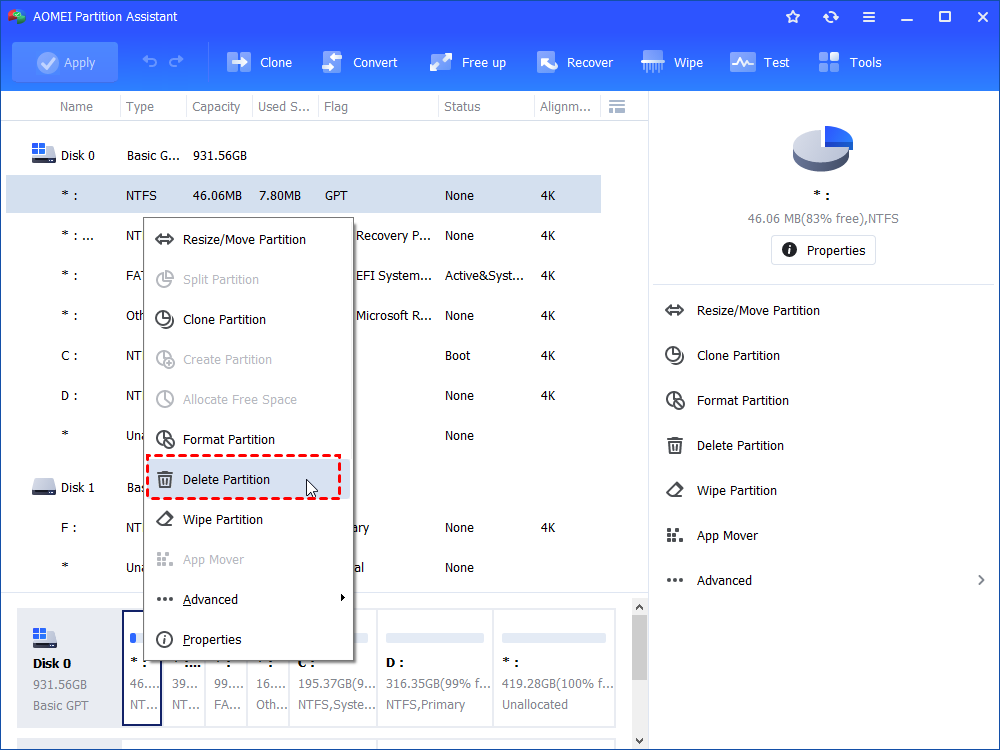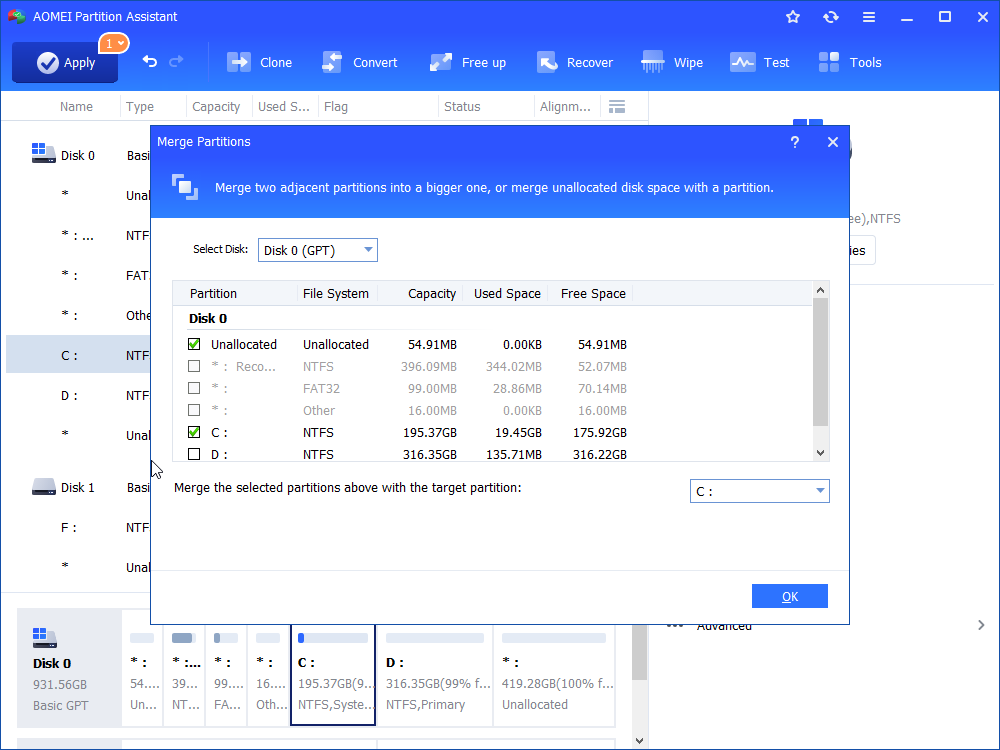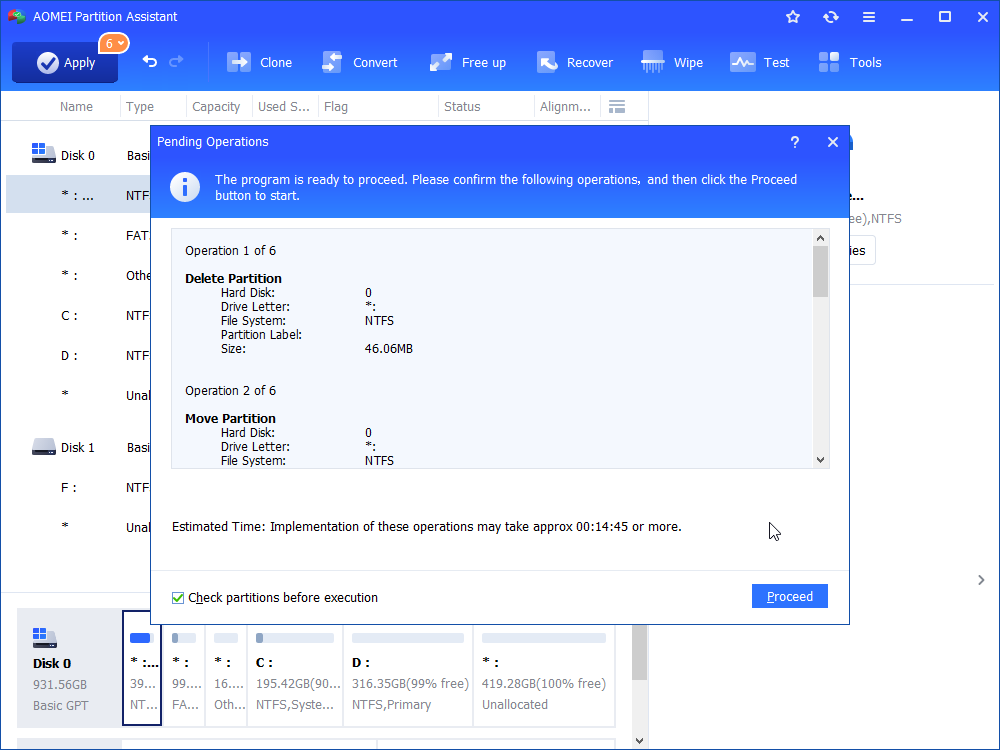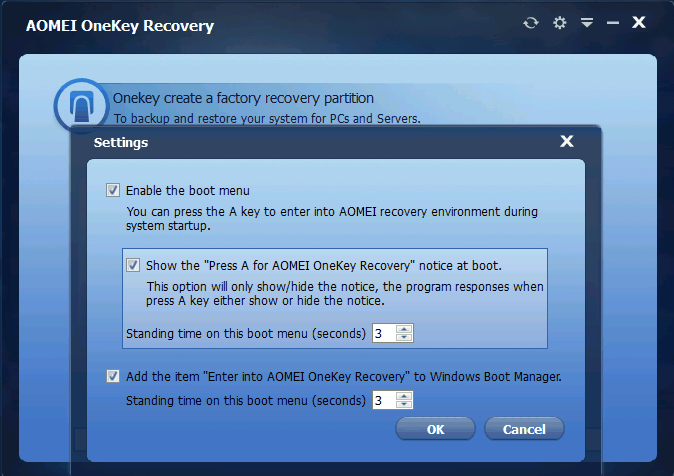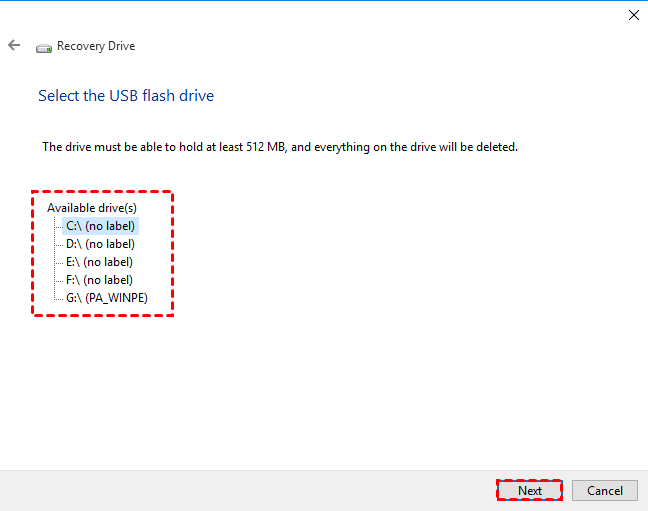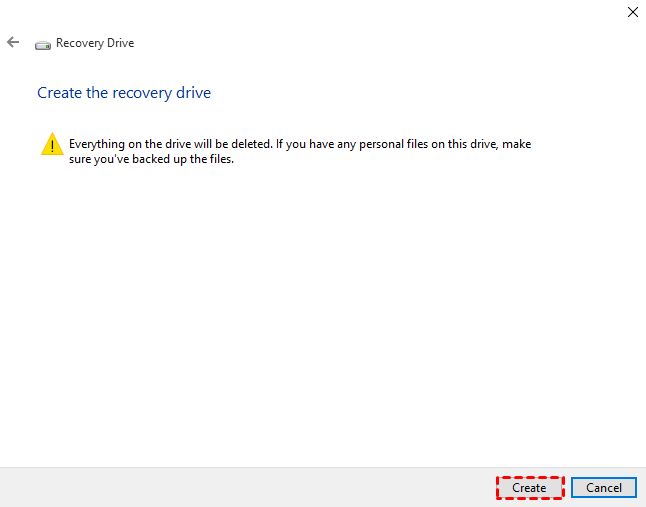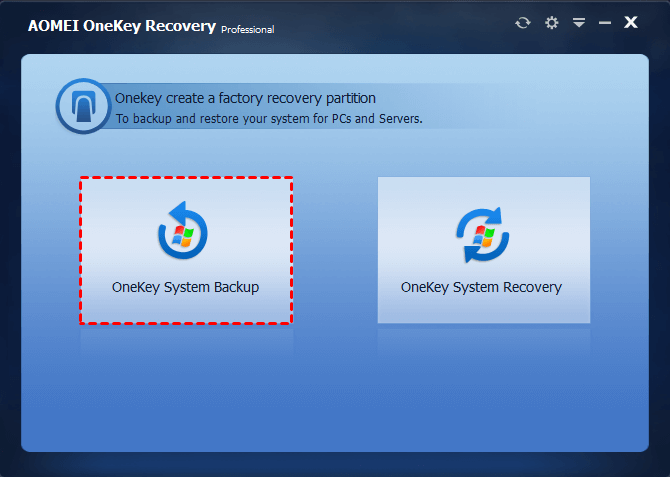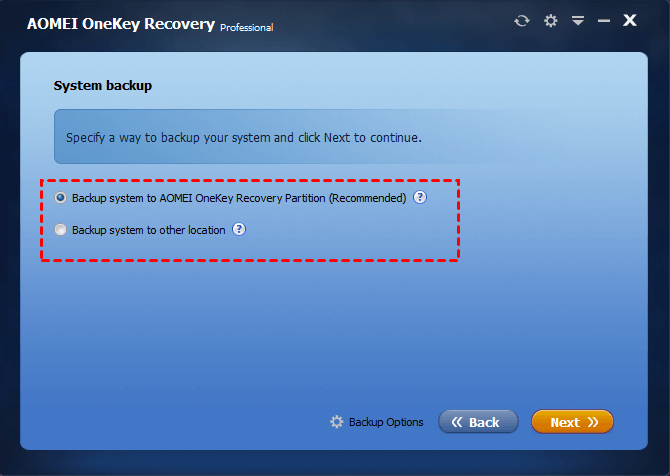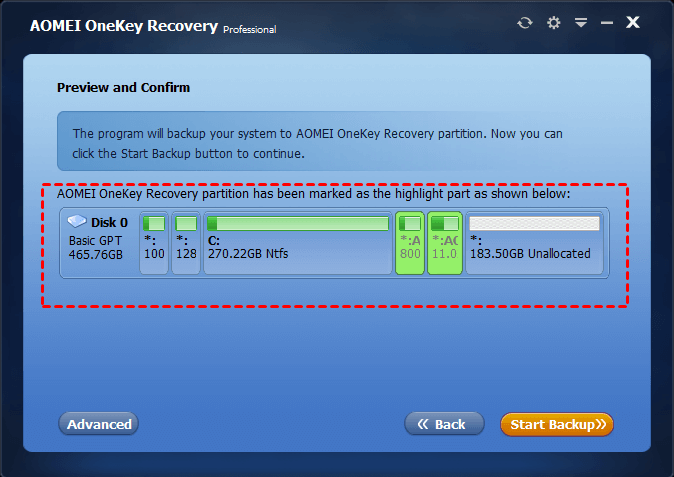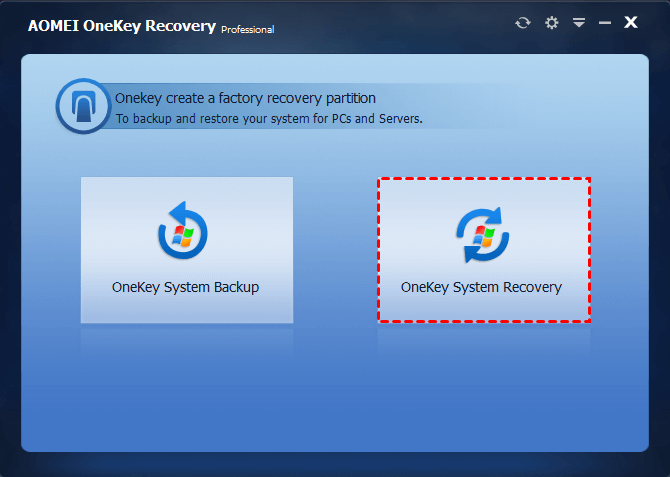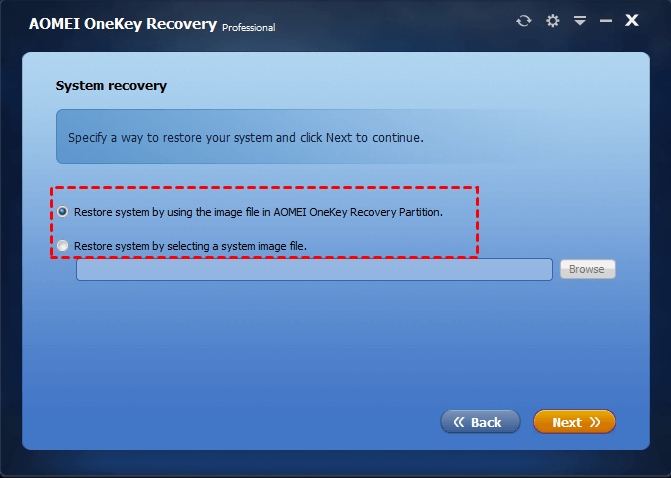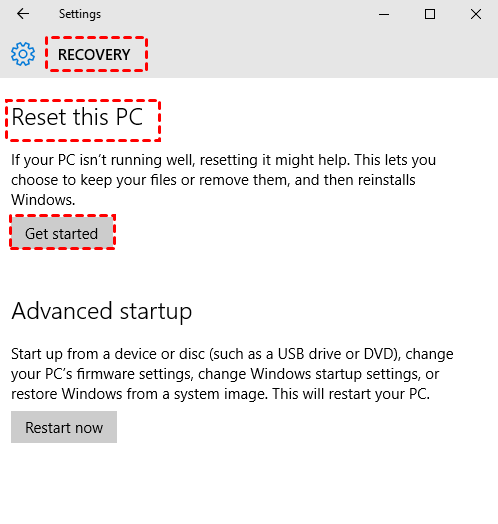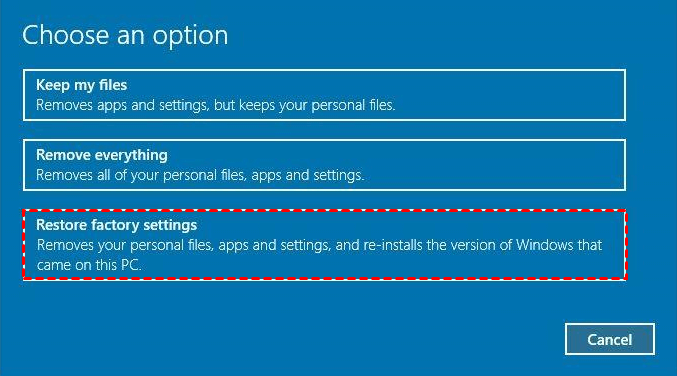- Create a recovery drive
- Recovery Partition After Upgrading to Windows 10 from Windows 7/8
- What Is Recovery Partition?
- Windows recovery partition
- OEM recovery partition
- Why An Extra Recovery Partition Created During Upgrade?
- How to Delete Recovery Partition in Windows 10?
- How o Create A Recovery Partition?
- How to Create Recovery Partition in Windows 10 (Step-by-Step)?
- Why Create Recovery Partition in Windows 10?
- How to create a recovery partition and restore in Windows 10?
- 1. Make a recovery drive with built-in tool
- 2. Restore system with built-in recovery drive
- Easily create system recovery partition and restore via AOMEI OneKey Recovery
- Part 1. Create a Windows 10 factory recovery partition
- Part 2. Quickly recover system with OneKey Recovery
- Another way to restore your computer
- Final words
Create a recovery drive
It’s a good idea to create a recovery drive. That way, if your PC ever experiences a major issue such as hardware failure, you’ll be able to use the recovery drive to reinstall Windows 10. Windows updates to improve security and PC performance periodically so it is recommended to recreate the recovery drive annually. Personal files and any applications that did not come with your PC will not be backed up. You’ll need a USB drive that’s at least 16 gigabytes.
Warning: Use an empty USB drive because this process will erase any data that’s already stored on the drive.
To create a recovery drive in Windows 10:
In the search box next to the Start button, search for Create a recovery drive and then select it. You might be asked to enter an admin password or confirm your choice.
When the tool opens, make sure Back up system files to the recovery drive is selected and then select Next.
Connect a USB drive to your PC, select it, and then select Next.
Select Create. Many files need to be copied to the recovery drive, so this might take a while.
If you ever need to use the recovery drive to reinstall Windows 10 on your PC, see Recovery options in Windows 10 for further instructions. It’s a good idea to back up your files frequently because the recovery drive isn’t a system image. It doesn’t contain your personal files, settings, or programs.
Need more options for creating a recovery drive?
To download Windows 10 installation media, see Recovery options in Windows 10.
Recovery Partition After Upgrading to Windows 10 from Windows 7/8
After upgrading Windows 7 or 8 to Windows 10, you find an extra recovery partition in Disk Management. What’s it for? Can you delete it? This article will tell you all about recovery partition.
By AOMEI 
What Is Recovery Partition?
Recovery partition is a small partition on your hard drive that can help you restore your Windows or troubleshoot system issues. There are two kinds of recovery partitions you may see in Windows 10/8/7.
Windows recovery partition
When installing a Windows operating system (OS) on a hard drive, and if you use Windows Setup to create new partition on an MBR disk, Windows will create a system reserved partition, and if it is a GPT disk, then Windows will create a recovery partition and an EFI system partition without drive letter. The recovery partition on Windows 10 consumes about 450MB, Windows 8/8.1 200MB, and Windows 7 100MB.
This recovery partition is to hold the Windows Recovery Environment (WinRE), which can be explored if you manually assign a drive letter to it. If you delete this partition, you won’t be able to use Windows Recovery options. If you create Windows 10 recovery disk, Windows will give you an option to remove the recovery partition. With the recovery drive, you can still use Windows recovery options. Otherwise, if you install Windows on a hard drive containing multiple partitions, Windows will save the WinRE in a folder named Recovery in the root directory of your system drive (C: drive) without leaving a recovery partition.
OEM recovery partition
Apart from the recovery partition of Windows, there may be another recovery partition created by the computer manufacturer like Lenovo and Dell that has made their computer comes with an OEM recovery partition consuming about 7 to 20 GB, which contains the WinRE and their factory installation files.
On some computers, the WinRE and the factory installation are separately stored on two partitions, so you may see two OEM partitions on your computer. This OEM partition allows you to press a specified key to boot into Recovery Environment, so you can recover your OS to factory setting without a Windows installation disc. If you have a copy of Windows installation, you can delete this OEM partition to free up more disk space.
Why An Extra Recovery Partition Created During Upgrade?
Every time when you upgrade Windows to the next version, the upgrade program will create a recovery partition if it detects that there is no sufficient space on your recovery partition (GPT disk) or system reserved partition (MBR disk). There is no wonder that you have many recovery partitions after upgrading to Windows 10. If you don’t want Windows to create another recovery partition, you can increase the size of recovery partition or system reserved partition before upgrading to Windows 10.
According to Microsoft, the previous Windows version recovery partition will be nonfunctional, so you can delete the previous recovery partition to free up some disk space. As you may know that Windows can only shrink a partition from its right side, so you can tell which recovery partition was newly created by upgrading to Windows 10. For example, as the screenshot below, the 100MB recovery partition was created when installing Windows 7, the 200MB recovery partition was created when upgrading Windows 7 to Windows 8, the 500MB recovery partition was created when upgrading Windows 8 to Windows 10, and the OEM recovery partition created by PC manufacturer before shipping.
As you see the new created Windows recovery partition stands in the way of extending system partition. If you do not want to delete the recovery partition, you can move Windows 10 recovery partition without data loss.
How to Delete Recovery Partition in Windows 10?
You cannot delete a recovery partition with Windows 10 Disk Management for it has crucial files, but you can use diskpart.exe to delete recovery partition. However, you still cannot extend the remaining partition with the new created unallocated space if the recovery partition appears before the C: drive. Hence, you need third-party partition software to do this job. AOMEI Partition Assistant Standard, a free partition software, can delete the recovery partition and extend a partition as long as there is unallocated space on the disk.
1. Download this free software. Install and launch it.
2. Right-click the recovery partition you want to delete and select «Delete Partition». Then you can see the recovery partition becomes an unallocated space. Actually no changes will be made until you confirm and click Apply.
3. Click «Merge Partitions«. In the pop-out window, check the unallocated space and the partition you want to extend.
4. Check the pending operations and click «Apply» and «Proceed» to save the changes.
This operation will complete under AOMEI PreOS mode, so do not be panic when your computer reboot.
How o Create A Recovery Partition?
Many users have met the problem that OEM partition won’t work after upgrading to Windows 10. What to do when you want to use recovery options only to find you have mistakenly deleted the recovery partition? You can use AOMEI OneKey Recovery to create a recovery partition on Windows 10 to backup and restore your current system including all the programs installed on C: drive. It also allows you to press a specified key “F1” or “A” to boot into AOMEI OneKey Recovery environment when your computer starts.
After creating the recovery partition, you can also keep the system backup image files in other locations besides the recovery partition, which means you can keep many system backups at the same time. When system fails to work, you can just press the Specified key to boot into AOMEI OneKey Recovery and select the system backup to restore system.
The recovery partition after upgrading to Windows 10 won’t consume much space on your hard drive, so it is recommended to leave it be. If you really want to get rid of recovery partition, backup essential files before deleting.
How to Create Recovery Partition in Windows 10 (Step-by-Step)?
​Accidentally delete Windows 10 recovery partition? You can manually create a recovery partition in Windows 10 with built-in tool or a third-party tool.
By AOMEI 
Why Create Recovery Partition in Windows 10?
Microsoft says Windows 10 no longer needs to create a separate recovery image. It will benefit most users, and save disk space for computers. Users are not concerned about computer breaks down. Once it does, you can use “Reset” to restore Windows 10 system. It seems that you don’t need to create recovery partition Windows 10.
However, it may mislead some users greatly. Windows 10 Reset function only restore your system to factory settings, and means that your Windows 10 will be reinstalled, but all software you added during the usage of computer will be disappeared. Most users regret not to create recovery partition Win 10 in advance.
Then, you may wander how to create custom recovery partition of Windows 10. In this article, I will introduce you 2 ways, you can use the built-in tool or a third-party tool AOMEI OneKey Recovery.
How to create a recovery partition and restore in Windows 10?
1. Make a recovery drive with built-in tool
Want to create a recovery drive in Windows 10 with USB instead of CD/DVD? Here is full guidance for you.
Preparations:
Prepare a USB flash drive with 16GB at least.
Create a backup for your USB drive if there are something important. All the data on the USB drive will be deleted during this process.
Step 1. Connect the USB drive to your computer and make sure it can be detected.
Step 2. Type “recovery drive” into the search box and select “Create a recovery drive” in the listed results.
Step 3. In the pop-out window, check the option “Back up system files to the recovery drive” and click “Next”.
Note: “Back up system files to the recovery drive” option is very useful, especially when you cannot troubleshoot your computer. It gives you a chance to reinstall your computer.
Step 4. Then select the USB flash drive connected before, and click ”Next” to continue.
Step 5. Click “Create” to begin creating the recovery drive.
2. Restore system with built-in recovery drive
Step 1. Boot from Windows 10 recovery USB drive.
Step 2. Select the keyboard layout.
Step 3. Select Troubleshoot.
Step 4. Select Recover from a drive and wait when you will receive a message like Getting things ready until the next window appears.
Step 5. Click Just remove my files or Clean the drive fully.
Step 6. Click Recover to start this process. It will take a while depending on the size of your hard drive and then your PC will restart.
Step 7. Follow the instructions to set up your Windows 10.
Easily create system recovery partition and restore via AOMEI OneKey Recovery
Part 1. Create a Windows 10 factory recovery partition
It is easier to create customized recovery partition of Windows 10 for users that hate to reinstalling system and other applications, software, etc. You can consider AOMEI OneKey Recovery and it is easy to operate with following the guidance. It allows you to create a recovery partition in Windows 10 for Lenovo, Samsung, Dell, HP, Acer, etc.
How to create recovery partition in laptop Windows 10 with AOMEI OneKey Recovery? First of all, download, install and launch it in your computer.
Step 1. Choose Onekey System Backup.
Step 2. There are two ways to backup system image. You can backup system to local system disk or other external disk. After choosing, click “Next” to move on. In this article, the first option is chosen as the example.
Step 3. Click “Start Backup” after confirming.
Note: AOMEI OneKey Recovery will spare some free space form the destination and create a recovery partition. If there is an unallocated space, AOMEI OneKey Recovery will store image to it by default. Then, you can preview the partitions layout via the “Advanced” option.
Part 2. Quickly recover system with OneKey Recovery
In the future, once if your computer can’t boot, you can press f11 or A to restore system back. When you reach the main page of AOMEI OneKey Recovery, choose the second option as the below picture shown.
The main process is:
Step 1. Choose a way to restore.
Step 2. Click Start Restore after confirming.
Another way to restore your computer
If you want to restore your computer to factory settings or you don’t need all data and software that are stored in C drive. You can follow the below steps to reset Windows 10.
Step 1. Go to Settings > Update & security > Recovery > Reset this PC, click Get started button
Step 2. Select Restore factory settings in the following picture.
Attention: This operation will remove personal files, apps and drivers you installed, and any changes you made to settings.
Step 3. Follow the on-screen instructions to restore your computer.
Final words
Creating a recovery partition in Windows 10 is essential. It can help you to repair your computer when accidents happen. You can use the built-in recovery drive feature or turn to a third-party tool like AOMEI OneKey Recovery. More so, you can use Reset this PC in Windows 10.
All of them can help you out of troubles. But they have a little difference. Recovery drive and AOMEI OneKey Recovery will restore your computer to a previous backup state while Reset this PC will factory reset Windows 10 and remove all the data and installed programs from hard drive.

